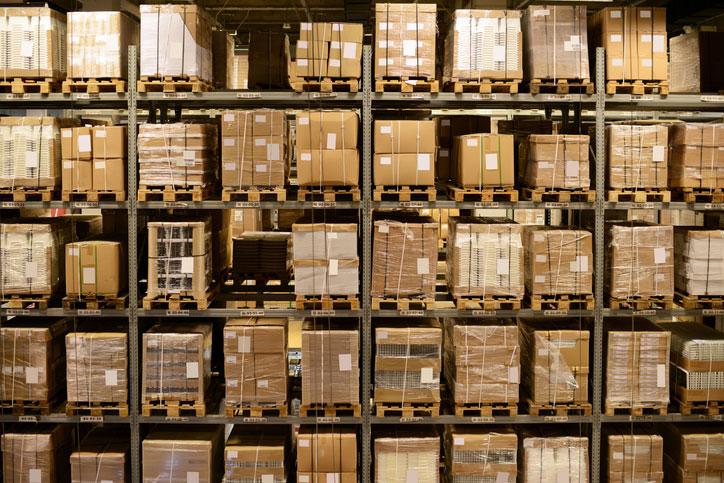Modernizing Your Warehouse: Steps to WMS Success
This is Part 4 of a five-part series for midmarket distributors looking to bring their warehouses into the 21st century and beyond. If you haven’t already, we recommend you start with Part 1.
WAREHOUSE TECHNOLOGIES AND CONSIDERATIONS
Managing inventory and warehouse operations is easy when you are small. Warehouse management becomes more difficult as distributors grow, adding more locations, large facilities, and larger product lines.
Growing distributors and those using entry-level accounting or legacy distribution ERP systems must modernize warehouse operations to remain competitive. This often warrants a replacement of the business system or the acquisition of expensive warehouse management software.
This series of articles provides wholesale distributors with an overview of warehouse management features and technologies. It includes a self-assessment to determine what steps to take next. It also provides WMS strategies and a process for executing WMS implementations to modernize warehouse and distribution center operations.
Now that we’ve assessed what you need to do to stay ahead of the game, let’s build a strategy to get there.
STEPS TO WMS SUCCESS
It is challenging to modernize warehouse operations without a comprehensive plan. You have technologies in place today but are they the right ones to take you to the next level? You have implemented features in your ERP system but are they set up properly and are there other features you could use? Set a strong foundation by researching options, prioritizing activities, and developing a detailed plan.
STEP 1: FOUNDATION
Modernizing warehouse operations is easier when you build on a modern ERP system. It will be much more difficult and costly to modernize if you use basic accounting or older ERP systems with few integration options and limited inventory or warehouse management features. Many distributors use a patchwork of technologies in their businesses. Maintaining integrations between too many applications is costly and inefficient.
1. Review Current ERP Features: Does your current business system provide a modern platform with an open architecture to connect to modern warehouse applications and technologies? Are there modules available that you can purchase to improve inventory and warehouse operations? Are there features you have not implemented that could improve business processes?
2. Upgrade or Replace ERP: Consider upgrading or replacing your current ERP software before any warehouse modernization project. You may be surprised to find that new versions of the software provide features that can help you better manage operations. Conversely, you may not realize that there are better options available for distributors in your industry.
STEP 2: RESEARCH
It is critical to research and document inventory and warehouse automation technologies so you can prioritize modernization activities. Review the detailed warehouse assessment section to see which features your current applications provide and where there are functional gaps for current and future needs.
1. Research Existing Capabilities: Document warehouse capabilities available in your current (or potential replacement) ERP system. How are these capabilities utilized in the system today? Can they be improved, or should they be replaced?
2. Identify Modernization Initiatives: Start small and work on high priority modernization activities first. Review the detailed warehouse assessment to identify gaps. You can then work on filling gaps for future requirements.
3. Review Potential Technologies: Contact your ERP partner to learn more about available modules, features, or third-party applications to improve inventory and warehouse operations. Do these applications and features fill most of your current and future gaps? Are they easily integrated? What are the costs?
STEP 3: PRIORITIZE
Review the list of functional gaps from the detailed warehouse assessment section. Rank each one based on cost and potential benefit. It is important to start small with a few high-priority activities. Look for ways to get more out of your current applications first. Be cognizant of cost. It is easier and less expensive to implement barcoding throughout your warehouse than it is to replace everything with RFID. Further, many advanced features can push you in to expensive WMS systems.
1. Improve Existing Warehouse Processes: Review previously completed modernization projects. Often, you can find ways to improve processes by tweaking setup or configurations. You may also discover innovative technologies to improve on previously completed modernization projects.
2. Implement New WMS Processes: Creating a modern warehouse takes time. Do not try to do everything at once. Consider activities that can be implemented quickly using existing functionality or where you can leverage previous investments in technologies.
STEP 4: DEVELOP A PLAN
Develop a plan that defines the desired goal, supporting technologies, and a timeline and process for conducting the implementation from start to finish.
1. Goals & Desired Outcomes: It is vital to clearly outline the expected results. Document the current state beforehand so you have a benchmark to use as a measure of your success.
2. Warehouse Automation Technologies: Document which technologies will be used, dependencies, integration points with other systems, known limitations, and provide contacts for assistance.
3. Timeline: You may not have a start date for the project, but you can develop the detailed phases and timeframes to complete each step in the process.
4. Contingency Plans: Define contingency plans in case you run into technical issues or other conflicts that prevent the completion of the project.
WHAT ACUMATICA CAN DO FOR YOU
Acumatica Cloud ERP provides the best business management solution for digitally resilient companies. Built for mobile and telework scenarios and easily integrated with the collaboration tools of your choice, Acumatica delivers flexibility, efficiency, and continuity of operations to growing small and midmarket organizations.
MODERN WAREHOUSE MANAGEMENT WITH ACUMATICA DISTRIBUTION EDITION
A modern warehouse is crucial for wholesale distributors to thrive in today’s digital economy. Entry-level business applications and legacy ERP software pose barriers to modernization projects forcing many distributors to invest in costly customizations or complex and expensive warehouse management systems.
Distributors need to understand inventory and warehouse technologies so they can improve and automate business processes. They must understand how to utilize ERP and WMS features effectively for inventory management, order processing, inventory transactions, warehouse automation, and compliance and reporting.
A disciplined strategy is critical to the success of warehouse modernization projects. The strategy establishes a solid foundation, provides research, and defines priorities for the modernization plan. A four-phased execution approach ensures that distributors are prepared for implementations with continuous review and process improvement.
Acumatica Distribution Edition provides a modern platform for wholesalers to modernize warehouse operations with tools to manage projects, support cases, and installations or upgrades. Through leading-edge cloud technology, Acumatica Distribution Edition delivers unparalleled value to small and midmarket distributors. Integrated workflows span the full suite of business management applications with native warehouse management and barcoding features.



